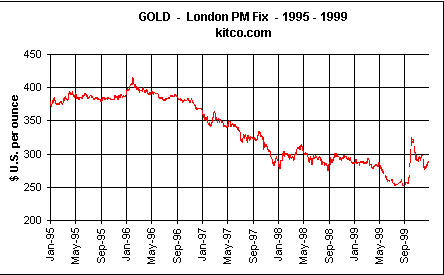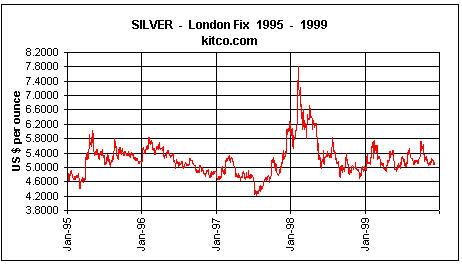How big miners are reliving the late 90’s bust: Steve Todoruk
Steve Todoruk, a mining veteran who joined Rick Rule in 2003 at Sprott Global Resource Investments Ltd. says he’s seeing some key similarities between today and the last big bear market for resource stocks, which lasted from around 1998 to 2001. Many of today’s mining legends made their reputation and their fortune during that time.
See Steve’s latest note below:
The last time we saw this happen was in the late 1990’s.
Gold was around $300 per ounce1; silver was near $5; and copper was $0.603 a pound.
Commodity prices had fallen so much that big miners were producing near or below the sale price of their product. In some cases, the more they produced the more money they lost.
Many mines had been shut down or were in the process of closing due to their inability to produce a profit.4
Copper miners needed around $1.10 per pound to make a decent profit. At $0.60 these companies were losing their shirts.
In the gold space, Goldcorp was one of the very few miners to eke out a small profit because they had only one mine, which happened to be one of the richest high-grade gold mines in the world.
Today, most industry experts believe that the ‘all-in sustaining cost’ to produce one ounce of gold is somewhere between $1,000 and $1,300. The all-in sustaining costs include all the costs of running current mining operations plus cash spent finding new ounces to replace mined reserves. Gold is trading around $1,200 right now, which means that most companies are probably losing money or breaking even. Few are making any kind of a profit.5
An important difference between the late 90’s and today is the amount of hedging. In the 90’s, companies often sold their gold forward (hedged), so when gold prices fell to $300, they had pre-sold a lot of their production at over $400 per ounce — enough to keep many mines open that would have almost definitely been shut down otherwise.
Over the last decade, investors demanded full exposure to a rising gold price as the reason to buy shares in producing miners. Companies listened and almost all eventually got rid of their hedging agreements. Few or none of the big producers hedge any gold to speak of.
As a result, gold miners today don’t have the benefit of having hedged some of their gold production at higher prices. They have to sell their production at the current market.
One temporary measure they can use is to mine only the high-grade areas of their deposit, but that game cannot last long and can greatly reduce the long-term production potential of a mine.
Throughout my life, I’ve been through 5 cycles in commodity prices, which correlate to bear markets and bull markets in mining stocks. Some cycles are more dramatic than others, but they all pretty well play out in the same way. You see a decline in the prices of the commodities and the share prices of the producers, followed by a rise in commodity prices and rising share prices.
In the late 1990s, the miners needed to start making money if the world economies wanted to continue having a supply of metals. This would also make money available for exploration of new deposits of gold, silver, copper, uranium, or other metals.
Smart investors bought shares in some of the miners since they stood to make money if commodity prices went up. They also bought up exploration companies with deposits that would increase substantially in value if metals prices rose. One of these companies was Bob Quartermain’s Silver Standard Resources (SSRI).
Ross Beaty of Pan American Silver (PAAS) was one of the ‘smart investors’ in the space. He went out and acquired a number of copper deposits that he believed were cheaply priced, and he was well-rewarded. My boss Rick Rule started his first two Limited Partnerships in 1998 and 2000, buying shares in companies like Silver Standard and Pan American Silver, to the delight of his investors when commodity prices started to rise in the early 2000s.
Today may offer a similar opportunity for investors. The miners are hurting. Mines may soon start shutting down, and that pain is also killing junior mining stocks.
There always will be a mining industry. The world needs the metals. The world also needs the junior miners since they make most of the discoveries which the majors end up turning into mines. Some companies will therefore survive – but probably not all.
One indication that a company may be viable is its ability to continue to raise funds in a bear market. On the other hand, the companies that cannot raise money tend to go quiet. They slow down or become inactive. Some merge with other companies or get bought out, and some simply close up shop.
It’s time to respond like we’re right back in the 90’s. Just like the ‘smart investors’ of that period, we want to choose the survivors that could become much more valuable if metals prices rise.
Steve recently commented that some stocks are staying well above their former lows, and that recent deals raise the specter of more mergers and acquisitions coming. These are encouraging signs, even if things could get worse before they get better. Read more here
P.S.: If you would like Steve to review your junior mining portfolio, please call him at 1.800.477.7853 or e-mail him at stodoruk@sprottglobal.com
Steve Todoruk worked as a field geologist for major and junior mining exploration companies after he graduated with a B. Sc. in Geology from the University of British Columbia, in 1985. Steve joined Sprott Global Resource Investments Ltd. in 2003 as a Senior Investment Executive.
Companies discussed above are used for examples only and do not constitute an endorsement or recommendation. If you would like more information, please contact a Sprott Global Resource Investments Ltd. broker.
1 Kitco Metals Inc. online
2 Kitco Metals Inc. online
3 Infomine.com
http://www.infomine.com/investment/metal-prices/copper/all/
4 The Wall Street Journal: Mining Firms Losing Weight In Gold. April 13, 1997
5 Kitco News: Barclays: 10% of Gold Production ‘Under Water’ For All-In Sustaining Costs. September 19, 2014
http://www.kitco.com/news/2014-09-19/KitcoNewsMarketNuggets-Sept-19.html
________________________________________
This information is for information purposes only and is not intended to be an offer or solicitation for the sale of any financial product or service or a recommendation or determination by Sprott Global Resource Investments Ltd. that any investment strategy is suitable for a specific investor. Investors should seek financial advice regarding the suitability of any investment strategy based on the objectives of the investor, financial situation, investment horizon, and their particular needs. This information is not intended to provide financial, tax, legal, accounting or other professional advice since such advice always requires consideration of individual circumstances. The products discussed herein are not insured by the FDIC or any other governmental agency, are subject to risks, including a possible loss of the principal amount invested.
Generally, natural resources investments are more volatile on a daily basis and have higher headline risk than other sectors as they tend to be more sensitive to economic data, political and regulatory events as well as underlying commodity prices. Natural resource investments are influenced by the price of underlying commodities like oil, gas, metals, coal, etc.; several of which trade on various exchanges and have price fluctuations based on short-term dynamics partly driven by demand/supply and nowadays also by investment flows. Natural resource investments tend to react more sensitively to global events and economic data than other sectors, whether it is a natural disaster like an earthquake, political upheaval in the Middle East or release of employment data in the U.S. Low priced securities can be very risky and may result in the loss of part or all of your investment. Because of significant volatility, large dealer spreads and very limited market liquidity, typically you will not be able to sell a low priced security immediately back to the dealer at the same price it sold the stock to you. In some cases, the stock may fall quickly in value. Investing in foreign markets may entail greater risks than those normally associated with domestic markets, such as political, currency, economic and market risks. You should carefully consider whether trading in low priced and international securities is suitable for you in light of your circumstances and financial resources. Past performance is no guarantee of future returns. Sprott Global, entities that it controls, family, friends, employees, associates, and others may hold positions in the securities it recommends to clients, and may sell the same at any time.
By Henry Bonner (hbonner@sprottglobal.com)
{{ commodity.name }}
{{ post.title }}
{{ post.date }}



2 Comments
Gary
Understandably this piece is written from an investors point of view, however spare a thought to the many thousands of miners around the world whose jobs are on the line due to the lower prices
ajaya choudhury
Trade cycle is the reality. How to come out of the bear period is the question for all. Those who survive are the winners. And the point is well said here. Garnering funds during crunch time is important. Be ready for the worst all the time is the message.